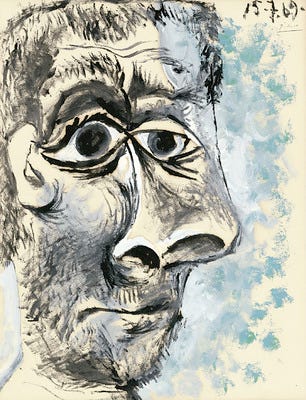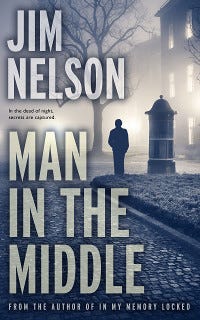Making the most of your writing notebook
The best writing notebook is the one that's with you.
You keep a writing notebook, right?
Years ago I attended an exhibition of Picasso’s sketchpads and notebooks. Museum-goers thronging the exhibit were fascinated with the charcoal and pencil scratchings of a 20th-century master. Most of the sketches were loose and ad hoc, even sloppy. None of Picasso’s originals were on display, only his sketches.
As artifacts, yes, the sketches were captivating. Imagine page upon page of the best doodles you ever saw. These doodles were the connective tissue between Picasso’s ever-exploring imagination and the masterpieces he produced. But the sketches were merely the early steps of a broader artistic process.
That’s why you should keep a writing notebook. If it’s good enough for Picasso—and Hemingway, and Henry James—it’s good enough for you.
Your writing notebook should be a free-form place. It’s for random ideas, bits of dialogue, strange notions, some fleeting language disconnected from anything rational. A writing notebook can hold drawings, things like maps or bizarre flora & fauna. It’s a place for bubble charts, genealogies, who-is-sleeping-with-whom diagrams, and the like.
My writing notebook is not merely for prose. When working on a novel, I’ll have a a page dedicated to listing the names of the book’s characters. This allows me to swiftly look one up if it slips my mind while writing chapters. For Bridge Daughter, I had pages of medical terminology, real and fictional, as the novel employed quite a bit of it and I wanted to ensure consistency.
I’ve inhabited a number of different writing notebooks over the years. I went through a phase of using the ever-trendy Moleskines, pocket-sized and hardbound with their handy elastic band to keep the book shut. Most memorable is their twee “As a reward: $______” on the inside cover, allowing the owner the opportunity to estimate the dollar value of their musings.
There exists numerous Moleskine knock-offs that are fine for the job. To mix things up, I’ve tried several different form factors. I once experimented with a high school composition notebook, thinking the different dimensions might yield unexpected fruit. (It did, but not in the way I was expecting—which was the entire point.)
Don’t get locked into one writing notebook manufacturer or model. Varying paper weight, rule widths, dimensions, and bindings will subtly produce variation in the words you pour across the pages. The same goes for ink and pens.
I avoided notebooks with graph paper for years, thinking the tiny blue squares would introduce too much inflexibility in my thinking. I was dead wrong—I purchased a thick Zequenz graph-paper notebook in Tokyo in late 2019 and have fallen in love with it. Now I worry that the pandemic will prevent me from buying another of these Thailand-based notebooks before I run out of pages. (Fortunately, they’re available on Amazon, although I hold out hope I’ll still get to buy my next one in Japan.)
I still refuse to use a notebook with unlined paper, though, which sounds like pure chaos for this writer, a man who can barely read his own cursive. For you? It might be the perfect fit.
Organization, schmorganization
As far as organization, I go minimal with my writing notebook. If I have a story or novel in mind, I’ll write my working title at the top of a fresh page, add the date for my own reference, and start writing. (I usually have at least one title in mind when I reach for my notebook, although there’s a good chance the title won’t survive.)
Even if my idea is merely one or two sentences, I’ll give it it’s own page. Don’t fear mostly-empty pages. There’s no reason to be aggressively economical with page use. Don’t worry if what you’re writing follows nothing you’ve written in the preceding pages, or even if you will use it at all later.
If you’re inspired to write, write.
Giving myself the freedom to write whatever I want to is important. Artificial barriers such as “I can’t write this until I’ve finished that” merely give me a reason not to write at all, the biggest threat for any writer.
I try to ensure I have my notebook handy whenever I’ll be in a place when I can allow my thoughts to wander and explore. No, I don’t carry it with me at all times. (I don’t even carry my smartphone with me at all times.) If it makes sense for you to keep it on you everywhere you go, do it—but don’t forget to carry a pen. One without the other is all-but-worthless.
To paraphrase photographer Chase Jarvis, the best writing notebook is the one that's with you.
Nothing is wasted
Returning to Picasso’s notebooks, another impressive aspect was their sheer volume. He produced tons of work he never intended to show or sell. His sketchbooks were for him, not us. They were a means to an end.
I’ve witnessed writers being stingy with their output. They view five pages of unpublished notebook prose as a “waste.”
Nothing is wasted. All writing is practice for the next round of writing. If you view every word in your writing notebook as precious and must be conserved like drinking water, you’re doomed.
View your writing notebook as a place to be sloppy and free, a place to expend language wantonly. Be verbose. Be chatty. Don’t worry about passive voice or tense changes.
I save all my old writing notebooks (for nostalgia, I suppose), but I don’t obsessively mine them for their ideas, thinking each little scrap of language or inspiration must be utilized. My notebooks brim with imaginative dead-ends. I’m fine with that. I’d rather my ideas sit in my notebook—off the vine, as it were—rather than go to waste on the vine: lost as fleeting thoughts that existed only for moments in my mind.
Adapted from an earlier post on j-nelson.net
2021 new mystery & suspense
Check out nearly twenty new mystery and suspense novels available for download today. Chills and thrills, as they say, with many available at a special price. Includes my timely novel of suspense, Man in the Middle, a paranoid thriller set in the first week of the pandemic.


